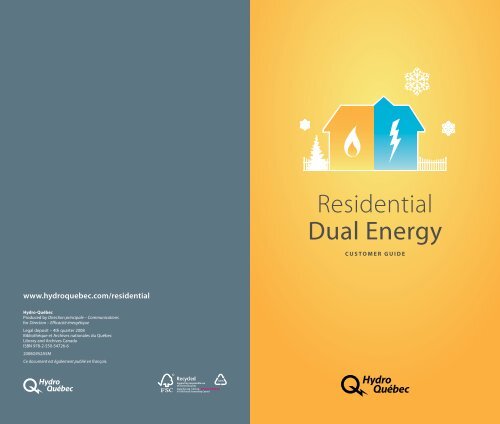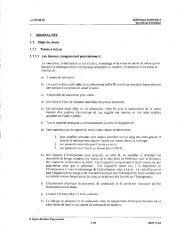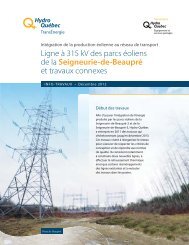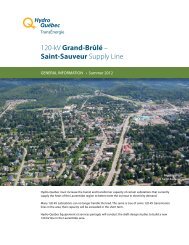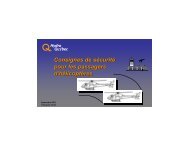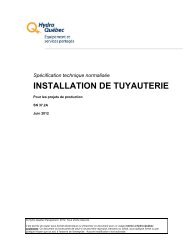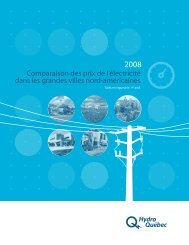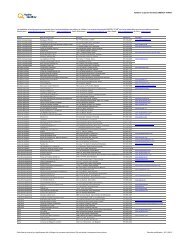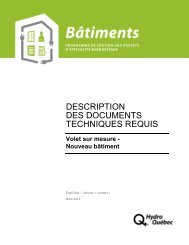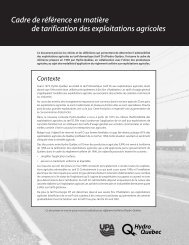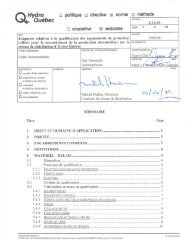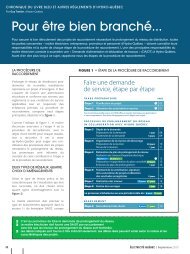Residential Dual Energy - Hydro-Québec
Residential Dual Energy - Hydro-Québec
Residential Dual Energy - Hydro-Québec
You also want an ePaper? Increase the reach of your titles
YUMPU automatically turns print PDFs into web optimized ePapers that Google loves.
www.hydroquebec.com/residential<br />
<strong>Hydro</strong>-<strong>Québec</strong><br />
Produced by Direction principale – Communications<br />
for Direction – Efficacité énergétique<br />
Legal deposit – 4th quarter 2008<br />
Bibliothèque et Archives nationales du <strong>Québec</strong><br />
Library and Archives Canada<br />
ISBN 978-2-550-54726-6<br />
2008G952A5M<br />
Ce document est également publié en français.<br />
XX-XXX-XXXXXX<br />
<strong>Residential</strong><br />
<strong>Dual</strong> <strong>Energy</strong><br />
Customer Guide
Table of contents<br />
<strong>Residential</strong> <strong>Dual</strong> <strong>Energy</strong>, a Worthwhile Choice 1<br />
<strong>Dual</strong>-energy heating system 3<br />
Electromechanical dual-register meter 6<br />
Electronic dual-register meter 7<br />
The indicator light: A warning to conserve and save 7<br />
Integrated dual-energy equipment 8<br />
Installed equipment 8<br />
Heat pump 8<br />
What to do if … 9<br />
Any questions? 9<br />
Your electricity bill 10<br />
Tracking your energy costs 12<br />
<strong>Residential</strong><br />
<strong>Dual</strong> <strong>Energy</strong>,<br />
a Worthwhile<br />
Choice<br />
The Customer Guide is designed to help you,<br />
as a user of a dual-energy system, achieve the best<br />
efficiency, savings and satisfaction from it. This<br />
guide will help you understand and use your system<br />
better. It describes the heating-system components,<br />
the electromechanical and electronic dual-register<br />
meters, the indicator light and the other equipment<br />
installed in your home.<br />
Your dual-energy system heats your home with<br />
fossil fuel, such as oil, during the periods when<br />
electricity demand is very high. These peak periods<br />
generally occur during the coldest winter weather.<br />
<strong>Dual</strong>-energy heating therefore plays an important<br />
role in the wise use of electricity.<br />
1
dual-energy<br />
heating system<br />
A dual-energy heating system uses electricity<br />
as the principal energy source and a fossil fuel,<br />
such as oil, as an auxiliary source.<br />
How it works<br />
If you are to get the most out of a dual-energy system, the switchover<br />
from one energy source to the other must be automatic. For this reason,<br />
your heating system has an automatic switch that reacts when an outdoor<br />
temperature sensor, usually built into the meter, sends it a signal at a<br />
specified temperature.<br />
• When the outside temperature is equal to or above the switchover<br />
temperature, the heating system runs on electricity, which is billed at the<br />
lower rate.<br />
• When the temperature falls below the switchover temperature, fuel<br />
heating takes over and the electricity used for other purposes is billed<br />
at the higher rate.<br />
2 3
Different moDes of operation<br />
The mode selection switch on the dual-energy system is used to choose<br />
whether the heating system runs on fuel, dual energy or electricity.<br />
For the heating system to switch automatically from electricity to fuel during<br />
high-rate periods and back again in low-rate periods, the switch must be in<br />
the <strong>Dual</strong> <strong>Energy</strong> position. Otherwise, the sensor doesn’t send signals to the<br />
heating system.<br />
In other words, to optimize the performance of your dual-energy system<br />
and benefit fully from Rate DT, leave your system in dual-energy mode.<br />
tHe best position: <strong>Dual</strong> energy<br />
When the mode selection switch is in the <strong>Dual</strong> <strong>Energy</strong> position, the<br />
outdoor temperature sensor controls the automatic switchover to the most<br />
economical energy source.<br />
4<br />
0 o C<br />
-12oC -15oC ELECTRICAL HEATING<br />
Low electricity rate<br />
SwITCHovER TEmpERATuRE<br />
−12°C, or sometimes −15°C,<br />
depending on your climate zone<br />
FuEL HEATING<br />
High electricity rate<br />
iNdiCAtor<br />
LiGHt*<br />
mode seLeCtioN<br />
sWitCH<br />
duAL-eNerGy<br />
HeAtiNG system<br />
duAL-reGister<br />
meter<br />
<strong>Hydro</strong>-QuébeC<br />
seNsor<br />
distributioN<br />
PANeL<br />
*optimal location<br />
5
electromechanical<br />
dual-register meter<br />
Unlike a standard meter, an electromechanical dual-register meter<br />
has two sets of dials.<br />
the upper register (red hands) counts the<br />
kilowatthours used during cold periods,<br />
when the temperature is below the switchover<br />
temperature. Your consumption is then billed<br />
at the higher rate. The indicator light goes on<br />
and stays on as long as you’re being charged<br />
the higher rate.<br />
the lower register (black hands) records<br />
the electricity consumed at the lower rate,<br />
when the temperature is equal to or above<br />
the switchover temperature.<br />
The meter comes with a box containing a sensor that reads the outdoor<br />
temperature. As soon as it drops below the switchover temperature,<br />
the sensor signals the heating system to switch from electricity to fuel.<br />
If the meter is located inside your home, the sensor is placed outside in<br />
a box usually attached to the power supply mast.<br />
electronic<br />
dual-register meter<br />
The electronic dual-register meter has<br />
an LCD display that shows the kilowatthours<br />
at the higher rate, then the kilowatthours<br />
at the lower rate. The rate is displayed as<br />
a number (02 = higher rate, 05 = lower rate)<br />
on the left side of the display (A = higher rate<br />
and B = lower rate).<br />
the indicator light:<br />
A warning to conserve and save<br />
The green indicator light on the meter is always<br />
lit and shows that the control mechanism is<br />
operating. The red indicator light next to it and<br />
another rate indicator light inside the house both<br />
go on whenever the dual-energy system is running<br />
on fuel. They show that the higher rate is being<br />
charged for electricity. You should cut back on<br />
your use of other electric appliances at those times.<br />
When the high-rate period ends, the red light<br />
goes off and your heating system switches back<br />
to electricity at the lower rate.<br />
6 7
integrated<br />
dual-energy equipment<br />
Integrated dual-energy equipment features an emergency switch, which<br />
should be left in the Normal position unless the electronic controller on<br />
the heating system has been damaged. If the switch is in the Emergency<br />
position, the system will only operate in fuel mode.<br />
installed equipment<br />
All installed equipment, except for the meter, belongs to you. You are<br />
therefore responsible for checking its condition and having it maintained.<br />
Heat pump<br />
<strong>Dual</strong>-energy systems with a heat pump have special features. The<br />
right-sized heat pump can generally provide comfortable heat without<br />
the aid of another energy source until its balance point temperature<br />
is reached. Here is how a dual-energy system with an air-air heat pump<br />
normally operates.<br />
• When the outdoor temperature is above the balance point, the heat<br />
pump alone is sufficient for heating.<br />
• When the outdoor temperature drops to the balance point or lower,<br />
the heat pump is assisted by the other energy source.<br />
• When the outdoor temperature falls below the switchover temperature,<br />
the heat pump stops operating and the auxiliary energy source takes<br />
over all heating.<br />
Note: A heat pump doesn’t affect the way the dual-register meter works.<br />
The switchover temperature is still −12°C (or −15°C), even if the heat pump<br />
requires assistance before that temperature is reached.<br />
balanCe point<br />
A few degrees below freezing.<br />
What to do if …<br />
tHe inDiCator ligHt is lit anD tHe system is still<br />
operating on eleCtriCity<br />
Your mode selection switch may be in the Electricity position. Reset it<br />
to the <strong>Dual</strong> <strong>Energy</strong> position.<br />
tHe inDiCator ligHt is off anD tHe system is still<br />
operating on fuel<br />
Your mode selection switch may be in the Fuel position. Reset it to<br />
the <strong>Dual</strong> <strong>Energy</strong> position.<br />
An indicator light lasts a long time and is rarely defective. Even if it doesn’t<br />
work, it doesn’t interfere with the automatic operation of your system. If you<br />
want to have it replaced, call your heating contractor.<br />
Any questions?<br />
The telephone number for <strong>Hydro</strong>-<strong>Québec</strong> Customer Services is on<br />
your electricity bill under Services à la clientèle. We’ll be happy to answer<br />
your questions.<br />
8 9
Your electricity bill<br />
You’ll continue to receive your electricity bill every two months,<br />
or every month if you’re on the Equalized Payments Plan.<br />
In winter, your bill may be slightly higher than it was before<br />
with Rate D. This is normal because, during very cold weather,<br />
your consumption is billed at a higher rate, even when your<br />
home is heated with fuel.<br />
Over a twelve-month period, however, you’ll save money.<br />
When the temperature is above the switchover point—and<br />
this is most of the time—your electricity consumption is<br />
billed at a lower rate.<br />
10 11
tracking<br />
your energy costs<br />
Use the table below to note your electricity<br />
and fuel costs, which add up to the total cost of<br />
your energy consumption.<br />
reCorD of <strong>Dual</strong>-energy Costs<br />
DATE ÉLECTRICITY FuEL ToTAL<br />
12


